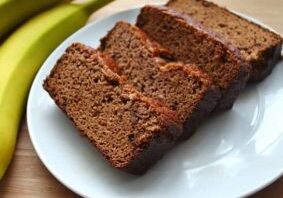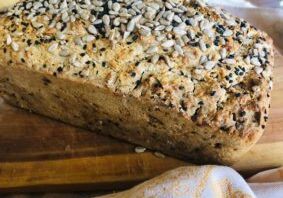Sourdough Buckwheat Bread
January 3, 2020
If you ever make it to the Ariege region, my favorite corner of France, you absolutely must reserve some time to enjoy the Thursday market at La Bastide-de-Sérou. While there are larger, busier and more extravagant markets to be found, I love La Bastide’s because it is not any of those things. It has a welcoming sweetness and authenticity that makes you feel as though you belong not only there at the market, but to the community itself. And while there are several items I covet from this particular market, the locally made sourdough buckwheat bread is almost worth the flight across the Atlantic. And apparently, I am not the only one who feels that way. I quickly discovered that there won’t be a crumb left waiting if you don’t arrive by 10 a.m.
And so it was my deep desire for this lovely bread, and the fact that my flight to France is still several weeks away, that prompted my experimenting in the kitchen. But nothing could begin until I located a good source for organic buckwheat groats, which turned out to be easier than I expected. I was delighted to come across this recipe from Breadtopia for inspiration. Just to be clear, this recipe is not for the spontaneous baker. You will need to plan a day and a half ahead of when you’d like to enjoy your bread. I found the wait to be completely worth it, and I am sure you will too.
Ingredients
- 4 cups raw organic buckwheat groats
- Filtered water to cover the groats
- 1 cup additional filtered water for the dough
- 2 tsp salt
- 3/4 cup pumpkin seeds
- 1/4 cup of sunflower seeds
- 4 Tbsp flax seeds or a mixture of flax, sesame and chia
- Mixture of seeds for the top of the loaf
- Loaf pan
- Parchment paper
Directions
Step One (6 hours long)
- Soak the buckwheat groats in water for 5-6 hours.
Step Two (24 hours long)
- Drain the groats in a colander without rinsing.
- Pour half of the soaked groats into a high-speed blender or food processor. Process groats until a smooth dough forms like a thick pancake batter, only adding water if needed for blending. Pour into a large glass bowl and repeat process with remaining groats. Cover with a towel and place in a warm spot (about 70 degrees). The dough will increase in size by approximately 25%, form a rounded top, and you will begin to smell the fermentation.
Step three (1 hour long)
- At this time, gently fold in the seeds and salt, being careful not deflate the dough more than necessary. Pour the batter into the parchment paper-lined loaf pan, sprinkling seeds on top if desired.
- Cover again with a towel and let the seeded batter rise for another hour in the same warm location.
Step four (95 minutes)
- Preheat the oven to 350 F for 15 minutes.
- Bake loaf for approximately 60 minutes, gently remove from pan and continue baking another 20 minutes on a baking stone or directly on the rack.
- You can check the loaf for an inside temp of 200 F if you are unsure if it is fully baked.
Step five (30 minutes)
- Remove from the oven and place on a cooling rack for at least 30 minutes before slicing.
- If the loaf will not be consumed within 48 hours consider slicing the entire loaf and freezing packets of a few slices, or store the entire loaf in your fridge.
- Toasting this bread brings out the best flavors.
Enjoy!
You may also be interested in:
Grain Free Banana Bread
Adapted from George Bryant (Civilized Caveman) Prep time 10 mins Cook time 60 mins Total time 1 hour 10 mins Serves: 8 or 12 muffins Ingredients •4 very ripe bananas (2½ cups mashed or 575 grams) •4 eggs (replace with ¼ chia seeds soaked in ½ to ¾ cup of water) •1/2 cup almond butter…
Sourdough Whole Grain Bread — 2021 Version
I love this recipe because it tastes like bread is meant to taste AND it is free from added starches, dairy products, eggs, and yeast. Although the actual effort that goes into this loaf is minimal the process must begin three days in advance. Ingredients ½ to ¾ cup of brown rice sourdough (which…
Sourdough Buckwheat Bread
If you ever make it to the Ariege region, my favorite corner of France, you absolutely must reserve some time to enjoy the Thursday market at La Bastide-de-Sérou. While there are larger, busier and more extravagant markets to be found, I love La Bastide’s because it is not any of those things. It has a…
Bake Your Own Flat Breads
I’ve raised three creative children who are, each in their own right, gifted in the kitchen. While the oldest two girls are fully launched with kitchens of their own, I still share mine with my youngest, Sebastian. To say he is an obsessive maker is hardly an exaggeration. And though much of his work is…




This sounds delicious! Most definitely will be making this!
Wonderful to hear Connie- let us know how you like it!